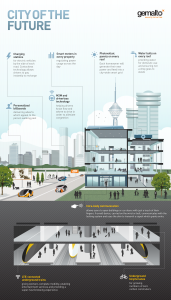By Carlos Romero, Business Development LATAM from Gemalto
In 1925, the magazine Popular Science predicted future cities that used technological advances to improve their residents’ quality of life. Just like in a science fiction movie, the magazine’s illustrators created an idyllic image of big cities with huge skyscrapers, electric transportation systems and more sustainable ways to manage life in the large cities.
Due to population growth and the modern technology innovation revolution, the cities described back then have moved from fantasy to reality.
 Today, “Smart Cities” are found all around the world and they are defined by the use of innovative communication technology used to optimize the use of resources, improve cost efficiencies, save energy, improve transportation systems and monitor and manage the infrastructure that keeps cities running smoothly. Modern smart city technology helps to reduce environmental impact and make city life easier and more efficient while offering a better quality of life for residents.
Today, “Smart Cities” are found all around the world and they are defined by the use of innovative communication technology used to optimize the use of resources, improve cost efficiencies, save energy, improve transportation systems and monitor and manage the infrastructure that keeps cities running smoothly. Modern smart city technology helps to reduce environmental impact and make city life easier and more efficient while offering a better quality of life for residents.
London, New York, Paris and Hong Kong are just some of the cities that benefit from new smart city telecommunication solutions. Major projects have been implemented in these popular cities to create sustainable transportation systems that help to reduce carbon emissions and commuting times.
Smart Urban Spaces (SUS), a pilot project recently launched in Europe, is leveraging 35 Near Field Communications (NFC) applications deployed to improve urban living across 11 cities from 4 different countries including Bilbao, Caen, Helsinki, Oulu, Seville and Valencia. Gemalto, the worldwide leader in digital security and Machine-to-Machine (M2M) technology, is leading the project offering its industry-leading solutions, software and services to facilitate improvements in public transportation, daycare centers, smart billboards, event information and taxi ride payments. The pilot program leverages the power and convenience of M2M and NFC technology to offer seamless, wireless communications that keeps users securely connected all the time and keeps processes running swiftly and smoothly.
In Latin America, Smart Cities are emerging more slowly. Santiago de Chile, Mexico City and Bogota are some of the first cities that are adopting smart technology solutions and encouraging technology innovation to improve traffic flow and keep pollution under control. More and more LATAM cities are moving toward adopting innovative technologies that improve urban efficiency, air quality and much more with innovations that help them earn the title of “Smart City”.
In Mexico, urban growth in Guadalajara, Puebla, Guanajuato, Monterrey, the Valley and other areas is driving adoption of new wireless technology solutions and initiatives that are making Smart Cities a reality. A fundamental part of this growth results from the use of innovative technologies, such as M2M, which allows the remote exchange of information between two machines or devices. These solutions are producing improvements in a variety of industries including healthcare, manufacturing and distribution, commercial services, automated energy consumption, efficient transportation, digital signage and much more.
According to estimates from the United Nations (UN), by 2050, 70% of the world’s population will be urban. This makes the “Smart City” model even more attractive for improving living conditions for residents. However, for the dream of highly efficient Smart Cities to become a reality, greater investment in education, technology, infrastructure and sustainable urban projects is required. Only then will we improve our ability for sustainable, highly efficient urban living while offering greater convenience and comfort for residents.
What makes a city smart?
- Charging stations for electric vehicles conveniently located just off freeways
- Smart Meters in homes and businesses that regulate energy consumption throughout the day
- Photovoltaic solar panels on every roof allowing owners to independently produce energy feeds into a smart electric network that powers the entire city
- Recycled rain water containers on every roof that provide water for domestic use, guaranteeing water conversation
- Personalized digital signs that provide relevant, personalized information for people passing by
- M2M technology that provides drivers with up to the moment information about traffic delays and the most effective routes.
- Biometric technology that confirms identity and allows users to open buildings, vehicles, computers and other secure areas with a simple touch of their fingertip
- Super speed train systems offering reliable wireless LTE 4G access providing users with constant access to networks anywhere
- Efficient bicycle lanes to assist the growing number of zero-emission vehicle users
The 8 Smartest Cities in Latin America
1.- Santiago de Chile
2.- Mexico City
3.- Bogota
4.- Buenos Aires
5.- Rio de Janeiro
6.- Curitiba
7.- Medellin
8.- Montevideo
Source: “The 8 Smartest Cities in Latin America”. Cohen, Boyd. http://www.fastcoexist.com/3022533/the-8-smartest-cities-in-latin-america#3, December 3, 2013.